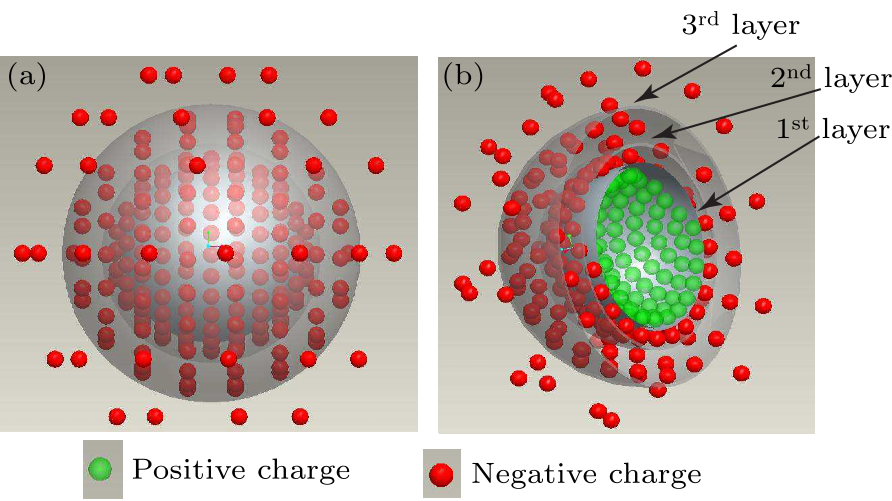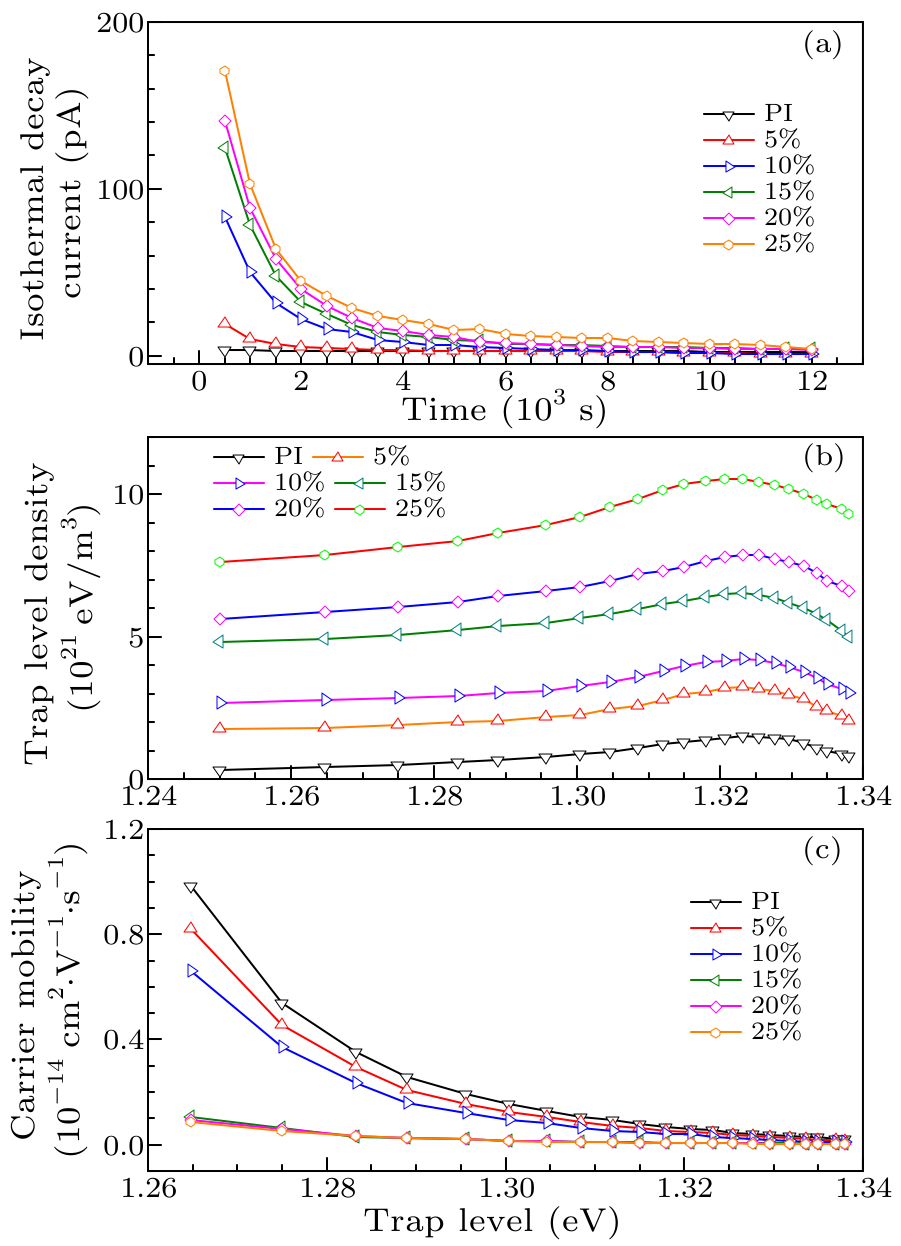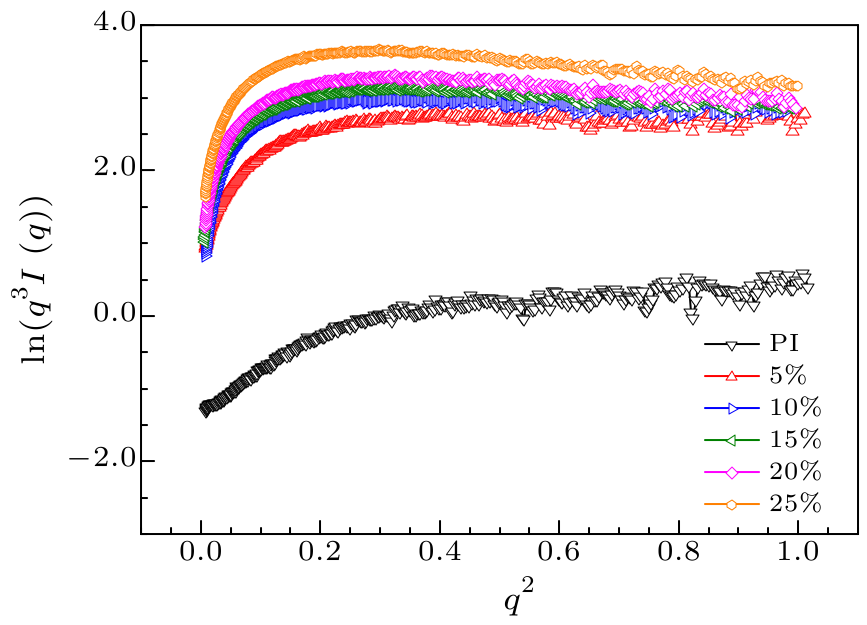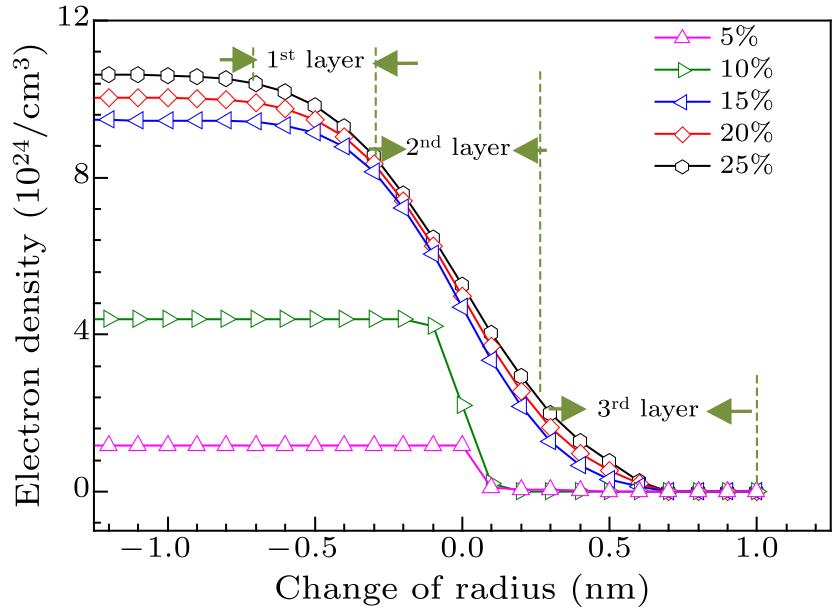
Fig. 1. The electron density distribution models for quasi two-phase mixture: (a) spherical model and (b) cross-section model.

Fig. 2. The characteristic curves of three kinds of nanocomposite films: (a) isothermal decay current $I$ versus time $t$, (b) trap level distributions $N(E_{\rm t})$–$E_{\rm t}$, and (c) $u_{\rm t}$–$E_{\rm t}$.

Fig. 3. The Porod test ${\rm ln}[q^{3}I(q)]$ of the PI/Al$_{2}$O$_{3}$ nanocomposite films versus $q^{2}$.
| Contents (wt%) | 5 | 10 | 15 | 20 | 25 |
|---|---|---|---|---|---|
| $D$ (nm) | 0.54 | 0.61 | 1.31 | 1.40 | 1.48 |

Fig. 4. The electron density distributions in the interface of nanocomposite films.
| [1] | Modesti M, Lorenzetti A, Bon D and Besco S 2005 Polymer 46 10237 | Effect of processing conditions on morphology and mechanical properties of compatibilized polypropylene nanocomposites
| [2] | Khun N W, Loong P Y, Liu E J and Li L 2015 J. Polym. Eng. 35 23 | Thermal, mechanical and tribological properties of polyamide 6 matrix composites containing different carbon nanofillers
| [3] | Tsai M H, Wang H Y, Lu H T, Tseng I H, Lu H H, Huang S L and Yeh J M 2011 Thin Solid Films 519 4969 | Properties of polyimide/Al2O3 and Si3N4 deposited thin films
| [4] | Ma P C, Nie W, Yang Z H, Zhang P H, Li G, Lei Q Q, Gao L X, Ji X L and Ding M X 2008 J. Appl. Polym. Sci. 108 705 | Preparation and characterization of polyimide/Al2O3 hybrid films by sol–gel process
| [5] | Feng Y, Yin J H, Chen M H and Lei Q Q 2014 IEEE Trans. Dielectr. Electr. Insul. 21 1501 | Influence of interface on the electrical properties of polyimide/TiO 2 composite films
| [6] | Tian F Q, Lei Q Q, Wang X and Wang Y 2011 Appl. Phys. Lett. 99 142903 | Effect of deep trapping states on space charge suppression in polyethylene/ZnO nanocomposite
| [7] | Zhang P H, Fan, Y, Wang, F C, Xie H, Li G and Lei Q Q 2005 Chin. Phys. Lett. 22 1253 | Conduction Current Characteristics and Carrier Mobility of Both Original and Corona-Resistant Polyimide Films
| [8] | Lewis T J 2005 J. Phys. D 38 202 | Interfaces: nanometric dielectrics
| [9] | Liu X X and Yin J H 2010 Chin. Phys. Lett. 27 096103 | Small-Angle X-Ray Scattering Study on Nanostructures of Polyimide Films
| [10] | Tanaka T, Kozako M, Fuse N and Ohki Y 2005 IEEE Trans. Dielectr. Electr. Insul. 12 669 | Proposal of a multi-core model for polymer nanocomposite dielectrics
| [11] | Mazzanti G, Montanari G C and Alison J M 2003 IEEE Trans. Dielectr. Electr. Insul. 10 187 | A space-charge based method for the estimation of apparent mobility and trap depth as markers for insulation degradation-theoretical basis and experimental validation
| [12] | Alison J M, Mazzanti G, Montanari G C and Palmieri F 2002 Annu. Report Conf. Electr. Insulation Dielectric Phenom. (Cancun Mexico 20–24 October 2002) p 35 |
| [13] | O' Konski C T 1960 J. Phys. Chem. 64 605 | ELECTRIC PROPERTIES OF MACROMOLECULES. V. THEORY OF IONIC POLARIZATION IN POLYELECTROLYTES
| [14] | Watson P K 1998 IEEE Trans. Dielectr. Electr. Insul. 5 21 | Dielectric investigation of thermally-induced chromophore degradation in nonlinear optical polymer electrets
| [15] | Wang X, Chen S Q, Cheng X and Tu D M 2009 Proc. CSEE 29 128 |
| [16] | Tanaka T 2006 IEEE Conf. Electr. Insulation Dielectric Phenom. (Kansas USA 15–18 October 2006) p 298 |
| [17] | Du B X, Li J and Du W IEEE Trans. Dielectr. Electr. Insul. 20 1764 | Surface charge accumulation and decay on directfluorinated polyimide/Al2O3 nanocomposites
| [18] | Yan G Y, Tian Q, Lui J H Chen B, Sun G A, Huang M and Li X H 2014 Chin. Phys. B 23 076101 | Small-angle X-ray analysis of the effect of grain size on the thermal damage of octahydro-1, 3, 5, 7-tetranitro-1, 3, 5, 7 tetrazocine-based plastic-bounded expolsives